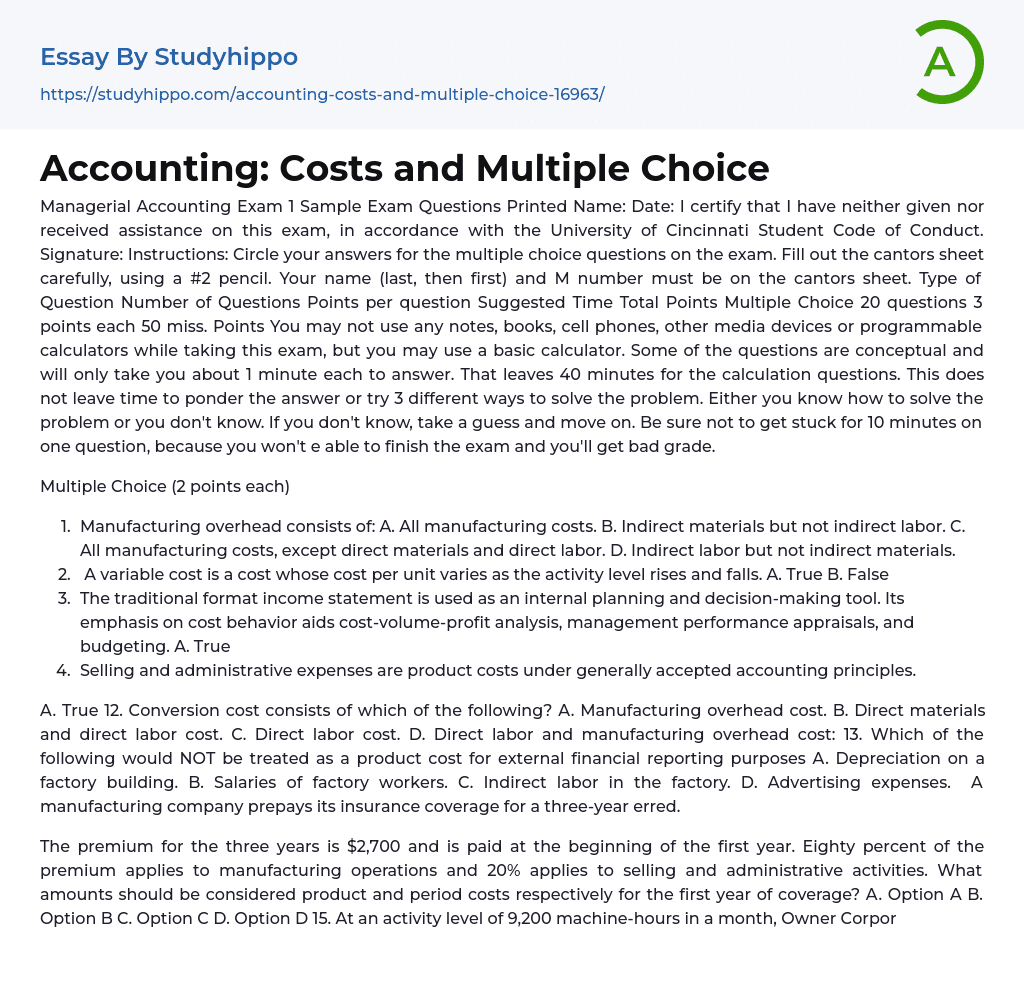I certify that I have neither given nor received assistance on this exam, in accordance with the University of Cincinnati Student Code of Conduct. Signature: Instructions: Circle your answers for the multiple choice questions on the exam. Fill out the cantors sheet carefully, using a #2 pencil. Your name (last, then first) and M number must be on the cantors sheet. Type of Question Number of Questions Points per question Suggested Time Total Points Multiple Choice 20 questions 3 points each 50 miss. Points You may not use any notes, books, cell phones, other media devices or programmable calculators while taking this exam, but you may use a basic calculator. Some of the questions are conceptual and will only take you about 1 minute each to answer. That leaves 40 minutes for the calculation questions. This does not
...leave time to ponder the answer or try 3 different ways to solve the problem. Either you know how to solve the problem or you don't know. If you don't know, take a guess and move on. Be sure not to get stuck for 10 minutes on one question, because you won't e able to finish the exam and you'll get bad grade.
Multiple Choice (2 points each)
- Manufacturing overhead consists of: A. All manufacturing costs. B. Indirect materials but not indirect labor. C. All manufacturing costs, except direct materials and direct labor. D. Indirect labor but not indirect materials.
- A variable cost is a cost whose cost per unit varies as the activity level rises and falls. A. True B. False
- The traditional format income statement is used as an internal planning and decision-making tool.
Its emphasis on cost behavior aids cost-volume-profit analysis, management performance appraisals, and budgeting. A. True
True 12. Conversion cost consists of which of the following?
- Manufacturing overhead cost.
- Direct materials and direct labor cost.
- Direct labor cost.
- Direct labor and manufacturing overhead cost: 13.
Which of the following would NOT be treated as a product cost for external financial reporting purposes
- Depreciation on a factory building.
- Salaries of factory workers.
- Indirect labor in the factory.
- Advertising expenses.
A manufacturing company prepays its insurance coverage for a three-year erred.
The premium for the three years is $2,700 and is paid at the beginning of the first year. Eighty percent of the premium applies to manufacturing operations and 20% applies to selling and administrative activities.
What amounts should be considered product and period costs respectively for the first year of coverage?
- Option A
- Option B
- Option C
- Option D
15. At an activity level of 9,200 machine-hours in a month, Owner Corporation's total variable production engineering cost is $761 ,300 and its total fixed production engineering cost is $154,008.
- Accounts Receivable essays
- Auditor's Report essays
- Balance Sheet essays
- Costs essays
- Financial Audit essays
- International Financial Reporting Standards essays
- Tax essays
- Accountability essays
- Cash essays
- Principal essays
- Management Accounting essays
- Internal Control essays
- Accounting Software essays
- Cash Flow essays
- Money essays
- Financial Accounting essays
- Market Segmentation essays
- Supply And Demand essays
- Purchasing essays
- Forecasting essays
- Legacy essays
- Bank essays
- Corporate Finance essays
- Financial News essays
- Financial Ratios essays
- Financial Services essays
- Free Market essays
- Shareholder essays
- Personal finance essays
- Equity essays
- Financial Crisis essays
- Banking essays
- Credit Card essays
- Currency essays
- Debt essays
- Gold essays
- Loan essays
- Enron Scandal essays
- Foreign Exchange Market essays
- Investment essays
- Venture Capital essays
- Stock Market essays
- Retirement essays
- Donation essays
- Net Present Value essays
- Income Statement essays
- Commercial Bank essays
- Debit Card essays
- Deposit Account essays
- Subprime Lending essays




